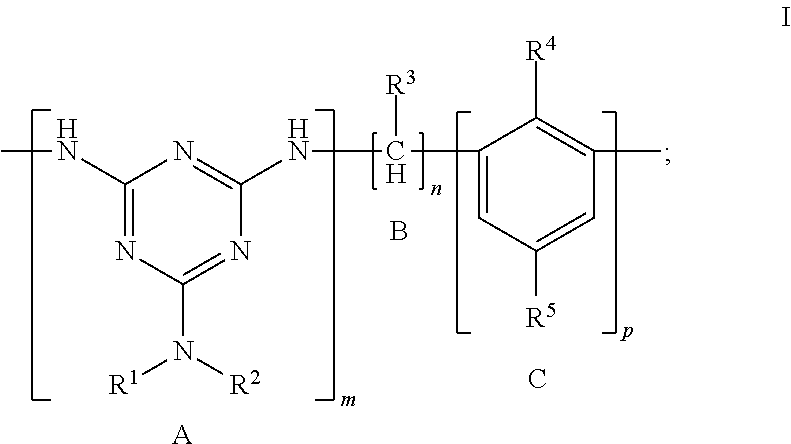Phosphorylated polycondensate as high efficiency water reducing agent and preparation method thereof
a high-efficiency, water-reducing agent technology, applied in the field of chemical building materials, can solve the problems of poor reaction activity of allyl ether ester monomer, complicated post-treatment, increased product cost, etc., and achieve the effect of high adaptability, strong adsorption ability, and new molecular structure and synthesis methods
- Summary
- Abstract
- Description
- Claims
- Application Information
AI Technical Summary
Benefits of technology
Problems solved by technology
Method used
Image
Examples
synthesis example 1
[0046](1) Preparation of Monomer A
[0047]126.02 g (1.0 mol) melamine, 86.10 g (1.05 mol) phosphorous acid and 100 ml water were placed into a 1000 ml reaction flask, 78.4 g (0.8 mol) sulfuric acid was added, the temperature was raised to 100° C. for 10 min, 97.30 g (1.2 mol) of a 37% aqueous formaldehyde solution was dropwise added, a condenser tube was installed, and the reaction was heated to reflux for 3 h and cooled for later use.
[0048](2) Condensation
[0049]250 g (0.1 mol) of a monomer C (phenoxypolyoxyalkylene ether) and 52.8 g (0.24 mol) of the monomer A (monosubstituted phosphorylated melamine) were sequentially added in a 1000 ml round-bottomed flask, the temperature was raised to 80° C., 21.08 g (0.26 mol) of a 37% aqueous formaldehyde solution was dropwise added, and the reaction was maintained at 120° C. for 6 h.
[0050](3) Neutralization
[0051]34.67 g (0.26 mol) of a 30% sodium hydroxide solution was added and 480 g water was added to adjust the system to a pH=8 to 9, to pre...
synthesis example 2
[0052](1) Preparation of Monomer A
[0053]126.05 g (1.0 mol) melamine, 90.20 g (1.1 mol) phosphorous acid and 100 ml water were placed into a 1000 ml reaction flask, 98.0 g (1.0 mol) sulfuric acid was added, the temperature was raised to 100° C. for 10 min, 85.14 g (1.05 mol) of a 37% aqueous formaldehyde solution was dropwise added, a condenser tube was installed, and the reaction was heated to reflux for 3 h and cooled for later use.
[0054](2) Condensation
[0055]450 g (0.1 mol) of a monomer C (phenoxypolyoxyalkylene ether) and 66.0 g (0.3 mol) of the monomer A (monosubstituted phosphorylated melamine) were sequentially added in a 2000 ml round-bottomed flask, the temperature was raised to 80° C., 22.70 g (0.28 mol) of a 37% aqueous formaldehyde solution was dropwise added, and the reaction was maintained at 110° C. for 5 h.
[0056](3) Neutralization
[0057]41.3 g (0.31 mol) of a 30% sodium hydroxide solution was added and 800 g water was added to adjust the system to a pH=8 to 9, to prepa...
synthesis example 3
[0058](1) Preparation of Monomer A
[0059]126.0 g (1.0 mol) melamine, 82.06 g (1.0 mol) phosphorous acid and 100 ml water were placed into a 1000 ml reaction flask, 19.6 g (0.2 mol) sulfuric acid was added, the temperature was raised to 100° C. for 10 min, 121.62 g (1.5 mol) of a 37% aqueous formaldehyde solution was dropwise added, a condenser tube was installed, and the reaction was heated to reflux for 3.5 h and cooled for later use.
[0060](2) Condensation
[0061]350 g (0.1 mol) of a monomer C (p-hydroxylphenoxypolyoxyalkylene ether) and 33.0 g (0.15 mol) of the monomer A (monosubstituted phosphorylated melamine) were sequentially added in a 2000 ml round-bottomed flask, the temperature was raised to 80° C., 14.60 g (0.18 mol) of a 37% aqueous formaldehyde solution was dropwise added, and the reaction was maintained at 130° C. for 7 h.
[0062](3) Neutralization
[0063]25.33 g (0.15 mol) of a 30% sodium hydroxide solution was added and 600 g water was added to adjust the system to a pH=8 t...
PUM
| Property | Measurement | Unit |
|---|---|---|
| Temperature | aaaaa | aaaaa |
| Time | aaaaa | aaaaa |
| Acidity | aaaaa | aaaaa |
Abstract
Description
Claims
Application Information
 Login to View More
Login to View More - R&D
- Intellectual Property
- Life Sciences
- Materials
- Tech Scout
- Unparalleled Data Quality
- Higher Quality Content
- 60% Fewer Hallucinations
Browse by: Latest US Patents, China's latest patents, Technical Efficacy Thesaurus, Application Domain, Technology Topic, Popular Technical Reports.
© 2025 PatSnap. All rights reserved.Legal|Privacy policy|Modern Slavery Act Transparency Statement|Sitemap|About US| Contact US: help@patsnap.com



